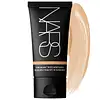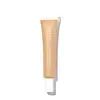What's inside
What's inside
 Key Ingredients
Key Ingredients

 Benefits
Benefits

 Concerns
Concerns

 Ingredients Side-by-side
Ingredients Side-by-side

Ethylhexyl Methoxycinnamate
UV AbsorberTitanium Dioxide
Cosmetic ColorantWater
Skin ConditioningDimethicone
EmollientButylene Glycol
HumectantPropanediol
SolventGlycerin
HumectantDiethylhexyl Succinate
EmollientNylon-12
PEG-9 Polydimethylsiloxyethyl Dimethicone
EmulsifyingPEG-10 Dimethicone
Skin ConditioningAluminum Hydroxide
EmollientDiphenylsiloxy Phenyl Trimethicone
Skin ConditioningSorbitan Sesquiisostearate
EmulsifyingDisteardimonium Hectorite
StabilisingVibrio Alginolyticus Ferment Filtrate
AbrasiveAlteromonas Ferment Extract
Skin ConditioningCurcuma Longa Root Extract
MaskingStearic Acid
CleansingDimethicone/Vinyl Dimethicone Crosspolymer
Skin ConditioningPolymethylsilsesquioxane
Trisodium EDTA
Ascorbyl Glucoside
AntioxidantPolysilicone-2
Talc
AbrasiveTocopherol
AntioxidantSea Salt
AbrasiveBHT
AntioxidantHydrogen Dimethicone
Parfum
MaskingPhenoxyethanol
PreservativeSodium Metabisulfite
AntioxidantCI 77891
Cosmetic ColorantCI 77491
Cosmetic ColorantCI 77492
Cosmetic ColorantCI 77499
Cosmetic ColorantEthylhexyl Methoxycinnamate, Titanium Dioxide, Water, Dimethicone, Butylene Glycol, Propanediol, Glycerin, Diethylhexyl Succinate, Nylon-12, PEG-9 Polydimethylsiloxyethyl Dimethicone, PEG-10 Dimethicone, Aluminum Hydroxide, Diphenylsiloxy Phenyl Trimethicone, Sorbitan Sesquiisostearate, Disteardimonium Hectorite, Vibrio Alginolyticus Ferment Filtrate, Alteromonas Ferment Extract, Curcuma Longa Root Extract, Stearic Acid, Dimethicone/Vinyl Dimethicone Crosspolymer, Polymethylsilsesquioxane, Trisodium EDTA, Ascorbyl Glucoside, Polysilicone-2, Talc, Tocopherol, Sea Salt, BHT, Hydrogen Dimethicone, Parfum, Phenoxyethanol, Sodium Metabisulfite, CI 77891, CI 77491, CI 77492, CI 77499
Water
Skin ConditioningCoco-Caprylate/Caprate
EmollientGlycerin
HumectantPolyglyceryl-3 Polyricinoleate
EmulsifyingLitchi Chinensis Pericarp Extract
Skin ConditioningTocopheryl Acetate
AntioxidantAscorbyl Palmitate
AntioxidantButylene Glycol
HumectantPolyhydroxystearic Acid
EmulsifyingMagnesium Sulfate
Citric Acid
BufferingEthylhexylglycerin
Skin ConditioningPotassium Sorbate
PreservativeSodium Salicylate
PreservativeCI 77891
Cosmetic ColorantCI 77491
Cosmetic ColorantCI 77499
Cosmetic ColorantCI 77492
Cosmetic ColorantWater, Coco-Caprylate/Caprate, Glycerin, Polyglyceryl-3 Polyricinoleate, Litchi Chinensis Pericarp Extract, Tocopheryl Acetate, Ascorbyl Palmitate, Butylene Glycol, Polyhydroxystearic Acid, Magnesium Sulfate, Citric Acid, Ethylhexylglycerin, Potassium Sorbate, Sodium Salicylate, CI 77891, CI 77491, CI 77499, CI 77492
 Reviews
Reviews

Ingredients Explained
These ingredients are found in both products.
Ingredients higher up in an ingredient list are typically present in a larger amount.
Butylene Glycol (or BG) is used within cosmetic products for a few different reasons:
Overall, Butylene Glycol is a safe and well-rounded ingredient that works well with other ingredients.
Though this ingredient works well with most skin types, some people with sensitive skin may experience a reaction such as allergic rashes, closed comedones, or itchiness.
Learn more about Butylene GlycolCi 77491 is also hydrated iron III oxide. It's sole purpose is to give a red/pink hue to products.
Iron III oxides are classified as inorganic chemicals for coloring.
Synthetically created Ci 77491 is considered safer than those naturally found. This is because the synthetically created version may contain less impurities. Iron oxides are generally non-toxic and non-allergenic.
Learn more about CI 77491Ci 77492 is also hydrated iron III oxide. It's sole purpose is to give a yellow hue to products.
Iron III oxides are classified as inorganic chemicals for coloring.
Synthetically created Ci 77492 is considered safer than those naturally found. This is because the synthetically created version may contain less impurities. Iron oxides are generally non-toxic and non-allergenic.
Learn more about CI 77492Ci 77499 is also hydrated iron III oxide. It is created from mixing red and black iron oxides. This helps give shades of darkness to a product.
Iron III oxides are classified as inorganic chemicals for coloring.
Ci 77891 is a white pigment from Titanium dioxide. It is naturally found in minerals such as rutile and ilmenite.
It's main function is to add a white color to cosmetics. It can also be mixed with other colors to create different shades.
Ci 77891 is commonly found in sunscreens due to its ability to block UV rays.
Learn more about CI 77891Glycerin is already naturally found in your skin. It helps moisturize and protect your skin.
A study from 2016 found glycerin to be more effective as a humectant than AHAs and hyaluronic acid.
As a humectant, it helps the skin stay hydrated by pulling moisture to your skin. The low molecular weight of glycerin allows it to pull moisture into the deeper layers of your skin.
Hydrated skin improves your skin barrier; Your skin barrier helps protect against irritants and bacteria.
Glycerin has also been found to have antimicrobial and antiviral properties. Due to these properties, glycerin is often used in wound and burn treatments.
In cosmetics, glycerin is usually derived from plants such as soybean or palm. However, it can also be sourced from animals, such as tallow or animal fat.
This ingredient is organic, colorless, odorless, and non-toxic.
Glycerin is the name for this ingredient in American English. British English uses Glycerol/Glycerine.
Learn more about GlycerinWater. It's the most common cosmetic ingredient of all. You'll usually see it at the top of ingredient lists, meaning that it makes up the largest part of the product.
So why is it so popular? Water most often acts as a solvent - this means that it helps dissolve other ingredients into the formulation.
You'll also recognize water as that liquid we all need to stay alive. If you see this, drink a glass of water. Stay hydrated!
Learn more about Water